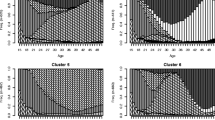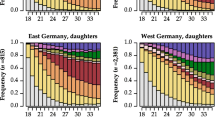Abstract
Employment, union formation and childbearing are central processes within young individuals’ transition to adulthood. These processes interact in highly complex ways, and they shape actual life-course trajectories that may be seen as a conceptual unit. In this article we use a methodology to cluster life-course experiences, where all three processes are embedded explicitly, in order to study young women’s trajectories in Great Britain. Drawing on a sample from the British Household Panel Survey (BHPS), we define life-courses as sequences on a monthly time scale and we apply optimal matching analysis to compute dissimilarities between individuals. We then use standard clustering algorithms and we identify nine distinctive groups of women. Our results are then shown using a new representation of clusters and interpreted in the light of the existing socio-demographic literature on the dynamic work-family link.
Résumé
Le travail, la mise en union et la procréation sont des processus centraux dans le passage vers l’âge adulte. Ces processus interagissent de manière très complexe, et modèlent les trajectoires biographiques, qui peuvent être considérées comme une unité conceptuelle. Dans cet article, nous utilisons une méthodologie pour catégoriser des expériences biographiques, en considérant que les 3 processus sont explicitement imbriqués, de manière à étudier les trajectoires des jeunes femmes en Grande Bretagne. A partir d’un échantillon du Panel Britannique des Ménages («BHPS»), la biographie est découpée en séquences sur une base mensuelle, et une analyse d’appariement optimale est appliquée pour calculer les dissemblances entre individus. Des algorithmes d’analyse de groupes sont ensuite utilisés, permettant d’identifier 9 groupes distincts de femmes. Les résultats sont illustrés à l’aide d’une nouvelle représentation des groupes, et interprétés à la lumière de la littérature socio-démographique sur la dynamique des relations famille-travail.

Similar content being viewed by others
Notes
Although not contained in the downloadable BHPS survey, complete work and family histories from both the retrospective and the panel component are available.
An interesting avenue for further research is to explore how to avoid the necessity to specify the cut-off point.
References
Abbott, A., & Hrycak, A. (1990). Measuring resemblance in sequence data: An optimal matching analysis of musicians’ careers. American Journal of Sociology, 96, 144–185.
Abbott, A., & Tsay, A. (2000). Sequence analysis and optimal matching methods in sociology. Sociological Methods & Research, 29, 3–33.
Beck, U., & Beck-Gernsheim, E. (1995). The normal chaos of love. Cambridge, UK: Polity Press.
Billari, F. C. (2001). The analysis of early life courses: Complex descriptions of the transition to adulthood. Journal of Population Research, 18, 119–142.
Billari, F. C., & Piccarreta, R. (2005). Analysing demographic life courses through sequence analysis. Mathematical Population Studies, 12, 81–106.
Billari, F. C., Fürnkranz, J., & Prskawetz, A. (2006). Timing, sequencing, and quantum of life course events: A machine learning approach. European Journal of Population, 22, 37–65.
Blair-Loy, M. (1999). Career patterns of executive women in finance: An optimal matching analysis. American Journal of Sociology, 104(5), 1346–1397.
Chan, T. W. (1995). Optimal matching analysis: A methodological note on studying career mobility. Work and Occupations, 22, 467–490.
Clarkberg, M., & Hynes, K. (2005). Women’s employment patterns during early parenthood: A group-based trajectory analysis. Journal of Marriage and Family, 67(1), 222–239.
Dijkstra, W., & Taris, T. (1995). Measuring the agreement between sequences. Sociological Methods & Research, 24, 214–231.
Elzinga, C. H. (2003). Sequence similarity: A non-aligning technique. Sociological Methods & Research, 31, 3–29.
Elzinga, C. H. (2005). Combinatorial representation of token sequences. Journal of Classification, 21(1), 87–118.
Elder, G. H. (1985). Life course dynamics trajectories and transitions, 1968–1980. Ithaca, NY: Cornell University Press.
Giele, J. Z., & Elder, G. H. Jr. (Eds.) (1998). Methods of life course research. qualitative and quantitative approaches. Thousand Oaks: Sage.
Goldin, C. (2006). The quiet revolution that transformed women’s employment, education, and family. 2006 Ely Lecture, American Economic Association Meetings, Boston MA.
Hakim, C. (2002). Lifestyle preferences as determinants of women’s differentiated labor market careers. Work and Occupations, 29(4), 428–459.
Hakim, C. (2003). A new approach to explaining fertility patterns: Preference theory. Population and Development Review, 29(3), 349–374.
Halpin, B., & Chan, T. W. (1998). Class careers as sequences: An optimal matching analysis of work-life histories. European Sociological Review, 14, 111–130.
Kauffman, L., & Rousseeuw, P. J. (1990). Finding groups in Data. New York: Wiley & Sons.
Lesnard, L. (2006). Optimal matching and social sciences, INSEE, Série des Documents de Travail du Crest, N. 2006–01, Paris.
Malo, M. A., & Munoz-Bùllon, F. (2003). Employment status mobility from a life-cycle perspective: A sequence analysis of work-histories in the BHPS. Demographic Research, 9, 119–161.
McVicar, D., & Anyadike-Danes, M. (2001). Predicting successful and unsuccessful transitions from school to work by using sequence methods. Journal of the Royal Statistical Association, Series A, 165, 317–334.
Modell, J., Furstenberg, F. F. Jr., & Hershberg, T. (1976). Social change and transitions to adulthood in historical perspective. Journal of Family History, 1, 7–32.
Moen, P., & Orrange, R. M. (2002). Careers and lives: Socialization, structural lag, and gendered ambivalence. In R. A. Settersten Jr., & T. Owens (Eds.), Advances in life course research: New frontiers in socialization (pp. 231–260). London: Elsevier Science.
Moen, P., & Sweet, S. (2004). From ‘work-family’ to ‘flexible careers’. Community, Work & Family, 7(2), 209–226.
Oechsle, M., & Geissler, B. (2003). Between paid work and private commitments: Women’s perceptions of time and life planning in young adulthood. Time and Society, 12, 79–98.
Ravanera, Z. R., & Rajulton, F. (2004). Work and family life trajectories of young canadians: Evidence from the 2001 general social survey, Discussion Paper no. 04–10, Population Studies Centre, University of Western Ontario, London, Canada.
Rindfuss, R. R. (1991). The young adult years: Diversity, structural change, and fertility. Demography, 28, 493–512.
Rohwer, G., & Pötter, U. (2005). TDA user’s manual. Bochum: Ruhr-Universität-Bochum.
Sankoff, D., & Kruskal, J. B. (1983). Time warps, string edits and macromolecules: The theory and practice of sequence comparison. Reading, MA: Addison-Wesley Publishing Company.
Scherer, S. (1999) Early career patterns: A comparison of Great Britain and Germany. European Sociological Review, 17, 119–144.
Schoon, I. (2001) Teenage job aspirations and career attainment in adulthood: A 17-year follow-up study of teenagers who aspired to become scientists, health professionals, or engineers. International Journal of Behavioral Development, 25, 124–132.
Schoon, I., McCullough, A., Joshi, H., Wiggins, R., & Bynner, J. (2001) Transitions from school to work in a changing social context. Young, 9, 4–22.
Settersten, R. A., & Mayer, K. U. (1997). The measurement of age, age structuring and the life course. Annual Review of Sociology, 23, 233–261.
Siegers, J. J., de Jong-Gierveld, J., & van Imhoff, E. (Eds.) (1991). Female labour market behaviour and fertility: A rational-choice approach. Berlin: Springer-Verlag.
Taylor, M. F., Brice, J., Buck, N., & Prentice-Lane, E. (2005) British household panel survey user manual volume A: Introduction, technical report and appendices. Colchester: University of Essex.
van der Heijden, P. G. M. (1987). Correspondence analysis of longitudinal categorical data. Leiden: DSWO Press.
Ward, J. H. (1963). Hierarchical grouping to optimize an objective function. Journal of the American Statistical Association, 58, 236–244.
Wu, L. L. (2000). Some comments on ‘Sequence analysis and optimal matching methods in sociology: Review and prospect’. Sociology Methods and Research, 29(1), 41–64.
Acknowledgements
We are grateful to participants of the Workshop “Becoming an Adult: an International Perspective on the Transitions to Adulthood, Montreal, 15–17 June 2006”. as well as to two anonymous referees of this journal for very useful comments and suggestions. The data (and tabulations) used in this publication were made available through the UK Data Archive. The data were originally collected by the ESRC Research Centre on Micro-social Change at the University of Essex, now incorporated within the Institute for Social and Economic Research. Neither the original collectors of the data nor the Archive bear any responsibility for the analyses or interpretations presented here.
Author information
Authors and Affiliations
Corresponding author
Rights and permissions
About this article
Cite this article
Aassve, A., Billari, F.C. & Piccarreta, R. Strings of Adulthood: A Sequence Analysis of Young British Women’s Work-Family Trajectories . Eur J Population 23, 369–388 (2007). https://doi.org/10.1007/s10680-007-9134-6
Received:
Accepted:
Published:
Issue Date:
DOI: https://doi.org/10.1007/s10680-007-9134-6




